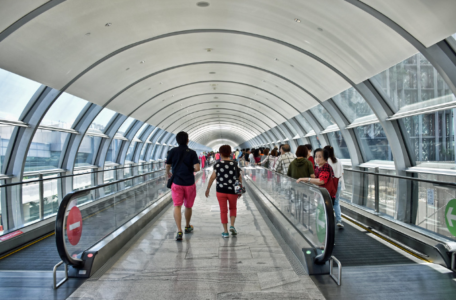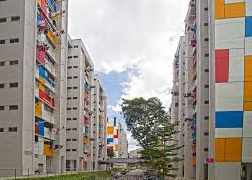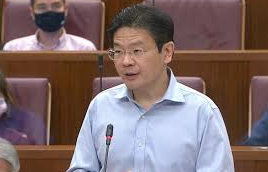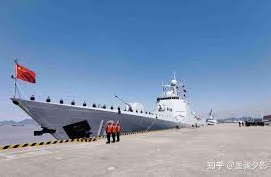The terminal is expected to be ready by the mid-2030s to accommodate anticipated air travel demand.
SINGAPORE: Changi Airport’s Terminal 5 (T5) project will move forward after a two-year pause attributed to “pandemic-fuelled uncertainties,” Transport Minister S. Iswaran announced on Tuesday (May 17).
“With the current and projected recovery in air travel demand, we are motivated to secure our infrastructural capacity for growth,” he stated during his opening address at the Changi Aviation Summit held at the Sands Expo and Convention Centre.
“We have used this two-year hiatus to conduct a comprehensive review of the T5 design, making it more modular and flexible while enhancing its resilience and sustainability. We will progressively re-engage our design and engineering consultants to update and refine the T5 design.”
Depending on the pace of recovery, construction of T5 is anticipated to commence in about two to three years, aiming for the terminal to be “ready to meet the anticipated demand around the mid-2030s.”
The T5 project was halted two years ago to first navigate the challenges posed by COVID-19, re-assess the trajectory of aviation growth, and learn from the pandemic to ensure the design meets the needs of post-pandemic travel, Iswaran added.
Expanding Programs and Enhancing Technological Capabilities
At the two-day summit organized by the Ministry of Transport and the Civil Aviation Authority of Singapore (CAAS), Iswaran addressed three critical aspects of aviation recovery: capabilities, capacity, and climate.
“To support aviation recovery and growth, it is essential to continue growing our aviation workforce and equipping them with the knowledge and skillsets to innovate and adapt to disruptions,” he remarked. He emphasized the need to build on the International Civil Aviation Organization’s (ICAO) initiatives, such as “No Country Left Behind” and “Next Generation of Aviation Professionals,” while also focusing on aviation safety and long-term sustainability.
As part of this initiative, the Singapore-ICAO Developing Countries Training Programme (DCTP) will be extended for another three years, providing US$1.6 million in training assistance through fellowships and scholarships. These will allow aviation leaders and professionals from developing ICAO Member States to attend specialized programs at CAAS’ Singapore Aviation Academy (SAA).
Fellowship recipients can participate in various training programs covering aviation management, safety, and security management, while scholarship recipients will earn diplomas in Civil Aviation Management or Aviation Safety Management. Additionally, CAAS has created programs to help aviation professionals learn from the COVID-19 pandemic.
Since its inception in 2001, the DCTP has trained around 1,500 government officials from 130 countries.
Enhancing Technological Capabilities
Iswaran highlighted the importance of technological advancements to complement efforts to expand the aviation talent pool. He noted that technology could further streamline and harmonize travel protocols, including the adoption of digital health certificates for easy authentication of travelers’ health statuses.
In a recent development, Singapore and the African Union have established a framework for the mutual recognition of COVID-19 vaccination certificates, adding to the array of digital vaccination certificates recognized in Singapore. Starting May 23, fully vaccinated travelers with digital certificates from Africa’s CDC Trusted Travel and Trusted Vaccines platforms can validate their vaccination status through Singapore’s Immigration and Checkpoints Authority’s Vaccination Check Portal.
Similarly, fully vaccinated travelers from Singapore can obtain secure vaccination passes on the African Union’s platforms. “Global cooperation within the aviation community is crucial to unlocking mechanisms for mutual recognition of digital health credentials, enhancing travel experiences, and accelerating the recovery of air travel,” Iswaran emphasized.
The government will also invest in new concepts for air traffic management and next-generation air navigation systems to ensure operational capacity aligns with expected growth in air traffic. The International Air Transport Association (IATA) forecasts that passenger air traffic in the Asia-Pacific region will grow at 4.5 percent annually over the next two decades, effectively doubling passenger volume.
Building Capacity for Future Demand
With borders reopening, Iswaran addressed the capacity of airports to manage the recovery of air travel. At the height of the pandemic in April and May 2020, passenger traffic at Changi Airport plummeted to just 0.5 percent of pre-COVID levels.
However, with the reopening of borders, there are “encouraging signs of recovery.” He noted that passenger traffic had more than doubled to over 40 percent of pre-COVID levels by May, up from under 20 percent in mid-March.
IATA’s Director-General Willie Walsh has indicated that overall air passenger numbers are expected to return to pre-COVID levels by 2023—one year earlier than previously anticipated.
“While there are valid reasons for optimism about future growth in air travel demand, we must not forget the capacity challenges that existed before COVID-19. To minimize ground congestion and delays in the air, we need to build up capacity in anticipation of demand,” Iswaran added.
Addressing Climate Change in Aviation
Iswaran also addressed the pressing issue of climate change and the need for the aviation sector to decarbonize. Prior to the pandemic, aviation accounted for over 900 million tonnes of carbon dioxide emissions globally, representing about 2 percent of total emissions.
“If we fail to act, the sector’s emissions could more than double by 2050 from 2019 levels, which is unsustainable for the aviation industry and its diverse stakeholders,” Iswaran warned.
Currently, over 100 states, including Singapore, are participating voluntarily in the Carbon Offsetting and Reduction Scheme for International Aviation under ICAO’s leadership. Singapore’s sustainable air hub blueprint aims to outline its ambitions, align the sector, and chart specific actions to decarbonize air travel.
The CAAS has formed an International Advisory Panel to guide the blueprint’s development and propose initiatives for airports, airlines, and air traffic management. Recommendations will be shared in July.
“We believe that global aviation is at a critical juncture. Two years ago, we faced a crisis that decimated air travel,” Iswaran reflected. “Today, we see the green shoots of recovery and encouraging signs of growth. These developments not only inspire optimism but also instill confidence to move forward with a focus on capacity, capabilities, and climate.”








